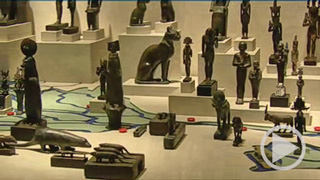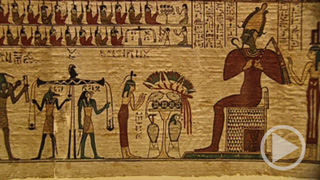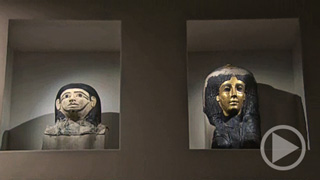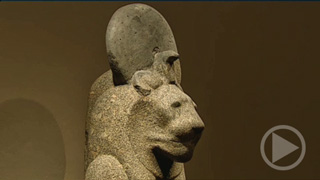
The Egyptian Museum and Papyrus Collection contains one of the world's most important collections of ancient Egyptian art, the highlights of which are exhibited in the New Museum ("Neues Museum") - including treasures such as the Berlin Green Head and a unique collection of finds from Amarna, the capital of Pharaoh Akhenaten.
His wife, Queen Nefertiti, whose portrait bust is one of the most famous works of art in world history, is considered the "most beautiful Berliner". The bust is almost three and a half millennia old - and yet so well preserved that it never had to be restored.
The Museum
The "Egyptian Museum and Papyrus Collection" is one of the most renowned collections in the world, on display at the spectacular "New Museum". The exhibition takes visitors through 4.000 years of one of the greatest and most evocative civilizations of human history, showing daily life along the Nile river, kings and gods, and life after death.Art from Amarna - Akhenaton and His Wife
Towards the end of the 18th dynasty, pharaoh Amenhotep IV came to power. In the fifth year of his reign he introduced a new religion, changed his name to Akhenaton and moved his capital to a newly built city he called Akhetaten. After his death, it was abandoned and forgotten - until it was rediscovered in the 19th century, now called Amarna.
Portrait Bust of Nefertiti
One of the world’s most famous works of art, the bust of Akhenaten’s queen has never been restored since it was found in 1912 by Ludwig Borchardt in the studio of Thutmose. Here the Chief Sculptor doesn’t show an ideal beauty but a very real person…▶ The Berlin Egyptian Museum▶ Amarna
01:34

Wooden Figure of Echnaton
Amarna art shows astonishing realism: pharaoh Akhenaton is shown as being rather lank with a slight stomach – far from a youthful hero. But then, he doesn’t need to be a great warrior: Aton, the new sun god, is a god of peace…▶ The Berlin Egyptian Museum▶ Amarna
02:51

The Portrait Head of Akhenaten
What did famous paraoh Akhenaten look like in the final years of his reign? This clay head from the Amarna workshop of his court artist Thutmose doesn’t portray him as a superhuman hero but rather as a very human person…▶ The Berlin Egyptian Museum▶ Amarna
01:59

The Statue of Nefertiti
Is Queen Nertiti shown naked? Not quite. But this statue probably shows her very much as she really was. The realism of art from Amarna corresponds to the new religion of Nefertiti's husband Akhenaten - celebrating life and creation in all its forms…▶ The Berlin Egyptian Museum▶ Amarna
01:50

A Walk in the Garden
In art from Amarna, the bond between man and woman often symbolizes the harmony between god and the world. This can include subtle erotics – and in this relief, the surpising depiction of a disability. Does it show Akhenaten’s son Tutankhamun and his wife?▶ The Berlin Egyptian Museum▶ Amarna
02:13
Gods
The people living in Ancient Egypt believed in a pantheon of gods who influenced all aspects of nature, of daily life and society. Ordinary people would ask the gods for help but the most important person was the pharaoh. He acted as a mediator between the people and the gods; it was his job to keep the gods happy and maintain order in the universe.
Geographical Distribution of Cults
It trip along the Nile following gods and goddesses. The Ancient Egyptian religion comprised a virtually infinite number of deities, and many of them can be assigned to a specific place where they were revered in particular…▶ The Berlin Egyptian Museum▶ Egypt
01:39

The Book of the Dead
The Book of the Dead is an illustrated papyrus dating back to around 1150 B.C. While his heart is weighed on the scales of justice, the deceased pleads his case before Osiris. If he fails he will be consumed by the Devourer of Souls…▶ The Berlin Egyptian Museum▶ Akhmim
02:43

The Mummy Masks
When somebody dies, they leave the realm of the living to reside among the gods. The mummy is needed for the transformation into an immortal being; each body part can be associated to a god. And, as the Egyptians wrote, gold is the flesh of the gods…▶ The Berlin Egyptian Museum▶ Thebes
01:33

The Statues of the Goddess Sekhmet
These statues of Sekhmet, or "She Who Is Powerful", combine several aspects of the Egyptian idea of the divine, from the sun discs to the superpower of a lioness. These attributes she uses as the goddess of war - but she also to provide protection…▶ The Berlin Egyptian Museum▶ Thebes
02:13
Life – Here and in the Afterworld
The Egyptians believed their souls would live on after death. So in order to ensure their survival, it was vital to provide tombs with goods, provisions, and offerings to sustain the bodies and spirits of the deceased. Today, it is mainly the graves with their decorations and furnishings that make the world of the Egyptians come alive...
Providing for the Afterlife: Burial Chambers
The chambers from the 3rd millenium BCE are decorated with reliefs that tell vivid stories from Egyptian daily life. We see farmers and craftsmen, family life and farm animals, a moving boat - and a door that only the soul can cross…▶ The Berlin Egyptian Museum▶ Saqqara/Memphis
02:09

Tomb Relief
Old Kingdom tombs, created between 2,600 and 2,200 BC, show vivid scenes of Egyptian daily life. Like a comic strip this relief shows how farmers harvest grain to provide for the deceased Seshem-nofer, though their donkeys are none too happy about it…▶ The Berlin Egyptian Museum▶ Giza
01:40
Pharaohs Carved in Stone
Egyptian art followed strong conventions that changed surprisingly little over a period of thousand of years. Pharaohs were always regarded as gods, and with few exceptions they were shown with idealized features. However, upon a closer look, we might be in for a few surprises...
Statue of Amenhet III.
What’s 600 years? This statue of Amenemhat III, who ruled around 1800 BC, was deliberately rededicated to Merenptah, son of Rameses II, about 1200 BC. Evidently Egyptian kings saw themselves as part of a tradition that could easily span half a millenium…▶ The Berlin Egyptian Museum▶ Saqqara/Memphis
02:18

The Head of a Statue of Sesostris III
A small granite head of the pharaoh dating from 1860 B.C. For a long time, historians thought sculptures like this didn’t portray individuals. But a closer look reveals a surprising story of how Senusret conquered the world – with words…▶ The Berlin Egyptian Museum▶ Saqqara/Memphis
02:49
Dignitaries and Their Families
Apart from wall paintings and reliefs, Egyptian art is most famous for its abundance for statues. In tombs in particular, archeologists found figures, not only of pharaohs but of high-ranking administrators and their wives. Thanks to the desert climate even many wooden statues have been preserved. They tell us a lot about the values of Egyptian society...
The Scribe Statue of Der-Senedj
In ancient Egyptian textbooks, the profession of scribe is valued more highly than any other line of work; the “scribe statue” is a basic form of Egptian sculpture. This one was made around 2600 BC to show the social status of a member of the royal household.▶ The Berlin Egyptian Museum▶ Giza
02:06

The Statue of Per-Her-Nofret
How do you show that somebody is ready for action - in a stationary statue? The ancient Egyptian sculptors found a way. The question is: does this statue from about 2400 BC show Per-her-nofret standing or walking…?▶ The Berlin Egyptian Museum▶ Kafr Ammar
02:10

The Block Statue of Petamenopet
Petamenopet probably lived in the early 7th century B.C.; his burial complex is the largest one in Thebes. The statue shows his facial features in an unusually realistic way – marking an artistically creative transition between tradition and new ideas…▶ The Berlin Egyptian Museum▶ Thebes
02:27

Statuette of Tadja
How does the tiny, delicate ivory figure of a seven-year-old child show us that Egyptian art could renew itself even after two and a half thousand years? And how was it influenced by African art from Kush, North Sudan?▶ The Berlin Egyptian Museum▶ Abu Sir el Malek
01:44

The Green Head
A close look at this world-famous masterpiece shows that it’s artistic quality goes beyond all normality. It is exceptionally lifelike - but we don’t know just who it is that we’re looking at; or even when and where the sculpture was created…▶ The Berlin Egyptian Museum▶ Egypt
02:30

The Family Statue of Ptahmai
What's in a statue? In this one, unique historical testimony from the era of Ramses II. (19th dynasty) found in Saqqara, the social status of a deceased officer, the fabric of his family - and, surprisingly, the equality of men and women...▶ The Berlin Egyptian Museum▶ Saqqara/Memphis
01:31
The Kingdom of Kush - a Bridge from Egypt to Africa
In the far south of Egypt, in what is today Sudan, between 350 BC to 300 AD the city of Meroe was capital of the powerful kingdom of Kush. For a hundred years during the 25th dynasty, the kings of Kush even ruled Egypt. Kushitic culture serves as a bridge between the Mediterranean world and Africa...
The Gold Treasure from Meroë
In the far south of Egypt, in what is today Sudan, between 350 BC to 300 AD the city of Meroe was capital of the powerful kingdom of Kush. In 1834, in the royal burial ground, the jewellery of Queen Aminshaketo was found – truly worthy of a queen!▶ The Berlin Egyptian Museum▶ Kingdom of Kush
01:12

Naga Reliefs
Naga, or Naqa was a metropolis of the ancient Kingdom of Kush with its capital of Meroe. For a hundred years during the 25th dynasty, the kings of Kush even ruled Egypt. Kushitic culture serves as a bridge between the Mediterranean world and Africa…▶ The Berlin Egyptian Museum▶ Kingdom of Kush
01:49
Address
- The Berlin Egyptian Museum
- Bodestraße
- 10178 Berlin
Links
Opening Hours
- Monday-Sunday 10:00-18:00
- Wednesday until 20:00
- Please check for opening hours
- during public holidays.




